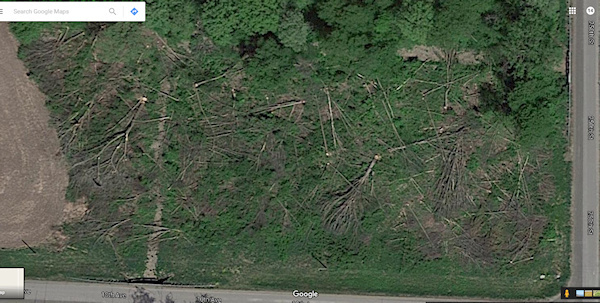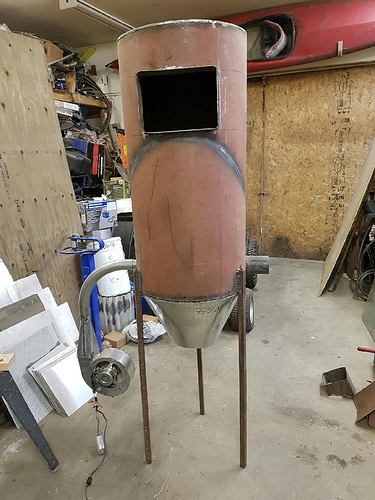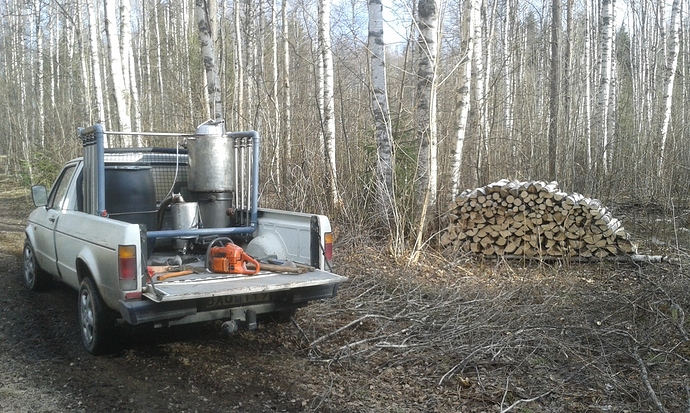Your getting some real nice trails built there bill, and you really got a lot done in short order, soon you will be finding time too dow and have some good logging trails too supply your vehicles, and heat sourse when needed, nice job when you get caught up it might seem like you retired. And will have a very nice place too retire too the new way of life.Farm Out Man.
Hi Thierry. Sorry for taking this long to respond. I have been working on a project, but it’s been stalled for quite a while. Essentially it’s a downdraft gasifier, meant to (hopefully) burn coarser chunk wood, reducing it to charcoal which will drop for storage. The fan is an ejector system to draw wood gas from slots in the bottom of the larger pipe, to be burnt in a refractory lined swirl burn chamber, then passed through a heat exchanger. The grate has a fixed, and a moveable part, to shake charcoal through, it would be stroked on a periodic cycle.
I think the concept is sound, but my design and execution may not be effective, as there has been no calculated design. At least it’s something to work with and learn from.
The tube is a Chinese steel coil liner, 20 1/2" diameter, 11ga, which allows using a steel barrel as either an insulation jacket or for air preheat.
.Hi Garry
Why did you choose a poel gasifier instead of a cooking oven ?
I can not imagine how to manage the extraction of coal from the zone of combustion continuously and automatically
By shaking the ash grid very strong, incompletely carbonized wood risks to pass from the coal side
Reversely by shaking too little, coal will be burned
Walking the dogs the other day I discovered a tall birch tree down. I fired up the Rabbit this morning, brought all the limbs home and chunked them.
I already completed firewood and stored away all equipment the other week. I decided to go back and do it Garry’s way with only chainsaw and splitting axe. Wonderful work splitting while listening to the birds singing and the best exercise there is.
Thierry, my theory is that the size of the grate openings will govern to a degree how quickly, and what size of char passes through. But a stationary system will need some sort of grate movement or external vibration. What I am building is a fixed coarse grate of vertical 3/8" steel, with a moveable grate above sliding on it. The moveable grate is actuated by a rod through the side. The moveable grate will be made from inverted stainless steel angles, as per Max’s advice, to trap insulating ash, and radiate the destructive heat.
I think this arrangement will allow finer char to slip through for collection, and coarser material can be broken by the grate action.
Regards,
Hi, Garry!
18.4.2017
If you want maximum utiliation of the char, do not use bar groups making “scissors”-action!
Keep the char above both groups. No less than 90 degrees above the groups to avoid “scissorsing”.
If you want spoiling char, then go for scissors action…
I just got back late this evening from living that same dream the last couple of days. The wood frogs have thawed out and are singing. The sandhill cranes are back up on my land, calling and flying timeless courtship rituals. Curious red tailed hawk and raven. My dog doesn’t approve… But I do. To appreciate and observe nature that way requires hours and days in the bush. Working wood with basic tools is the best exercise. I worry that skill with an axe is almost a dying art.
Regards,
I am trying this approach to try to achieve a continuous process. An oven or retort process is a batch process, and releases a large amount of heat with little ability to regulate. That will lead to system complexity, for heating needs a large thermal mass, water, will be needed to absorb the vast amount of heat. The gasification systems can also be regulated for greater or lesser energy output without reduction in quality of gas / char.
Up until 10 years ago I split all my annual 6-7 cord with axe only. The very last year I did that I had to cut a 5 year supply one single spring because all wood lots were beeing rearanged and felling was not allowed during that period. Ever since I’ve had a sore neck every time I overdo things. Small batches like these are ok and much more enjoyable 
Wow. That’s a lot of wood, and a level of regulation unknown over here, but our wood resources are hardly strained. Even bulldozing of standing forest and bluffs for farming isn’t regulated, which is too little regulation, I feel…
Working fuel wood largely by hand is very demanding work. Like all exercise it can easily be overdone, especially as one gets older.  especially in the winter, when people tend to be not in highest physical shape.
especially in the winter, when people tend to be not in highest physical shape.
On the other hand, splitting in lengths on the ground is arguably easier than using a hydraulic splitter, as there’s no need to bring all the wood to one machine, and then lift it all. Besides, here that means fighting with the snow. That was the origin of the system, pioneers aimed for maximum ease, and minimum work.
Hi Garry
I am very anxious to see the evolution of your project. I have built a retort process (wood baking oven) and I now face the challenge of burning the gas well and recover the BTU
My strategy for managing the flow of gas from the wood baking oven is to try to divert some of the gas to another burner (boiler). The idea is to control the temperature of the pyrolysis to stretch it over time.
In other words, gradually cupping the wood, to regulate the gradual release of pyrolysis vapors
Now that’s a beast!
The amount of power that must take…
Regarding bulldozing a forest:
A guy bought a mostly tillable 40 from us 2 years ago and decided that he would cut down the 3 acre woods on the corner of it. They had some guy come in and drop all the trees by cutting in at a 45 degree down angle from each side towards the center. He simply kept going with the second cut until the tree fell over. This process barber-chaired about half of them. What mess. You couldn’t even walk through it. Trees scattered everywhere, like after a tornado.
Well, he offered a me a few logs, mostly 40 year old black walnut and I took them.
Then he rented a huge end loader and started pushing and dragging all the remaining trees into piles. After that one guy came in and worked the piles over a little for firewood and a few slabs, He used a really long-bar chain saw mill. But he quit because of all the dirt and mud on the trees from the bulldozing kept dulling his chains. He told me that even carbide chains quit cutting! Now, no one even wants to make firewood out of the rest. I guess that’s the point of this post. All that’s left, as far as I can see is to burn it where is sits. And no, he still hasn’t grubbed out the stumps.
Pete Stanaitis
What a shame to even cut down Black Walnut.
Bill, you are correct.
I tried to get him interested in keeping that small woodlot by having he and his wife come out and pick black walnuts that fall.
We had planted almost everything that he cut back in about 1975, as seedlings, so it was kinda hard seeing it all laying on the ground.

But he wants to farm every bit that he can. Fortunately only one of those black walnut logs was split and we were able to work around it at the sawmill. OT, but we had a good time there, teaching and learning different ways of quarter sawing those and some other red and white oak logs that I brought to the mill.
Pete Stanaitis
Is there anyone with a debater near you? That is the only way to deal with logs that have been dragged through the mud like that. It is a shame true sign that somone doesn’t know what they are doing when the fill logs with dirt.
I made a sewing desk and a shelf with Walnut. It was the most enjoyable wood I’ve worked with. Very easy to work with and looks great with a finish on it. I got 1st place ribbons for both of those at our county fair and placed 3rd with both at our state fair.
This evening I was admiring a walnut tree I planted by my workshop 20 years ago, now substantial, even more amazing because this is far beyond the historical range of walnut. I am often wondering if the genetics are extraordinary, or if it’s the climate that has changed. I might even live to see some of the trees I planted milled into lumber.
My dad was a professional bulldozer operator, farmer, and conservationist. This led to moral conflicts. As a young child some of my first memories were of carefully stepping amongst the near carpet of poison ivy, to access the juneberries, raspberries, nannyberries, high bush cranberries and chokecherries, while admiring in amazement the lady slippers, and many flowers, the seeming never-ending variety of insects. My brother and I were so happy to hear the tree frogs singing in early spring.
Dad bulldozed almost all the forest to make it into fields, including a grove of wild plums, and next to it a golden eagle nest in the top of a 70ft trembling aspen, perhaps the last southern nest in Manitoba. Such majestic birds.
An expert bulldozer operator, and working on dry ground, the windrows of elm, ash, oak and poplar were quite clean. But being a tangled mess, were burnt once dry. A small bit of firewood was recovered. Dutch elm disease would soon come and devastate the remaining elm canopy, the last of the great elm forest in North America.
Now my parents complain about the clearing out of adjacent land, and how the wind blows the soil, that the neighbours have no respect for the environment. Their water table has dropped becoming unreliable, not as it was before.
We certainly are a destructive species. Short views, very short lives, and always ready to take a little bit more than how we knew it when young.
After retiring, dad bought a portable sawmill. It’s my impression that we could have made more value, with less work from a continuously renewing forest than as carbon depleted, denuded farm land.


